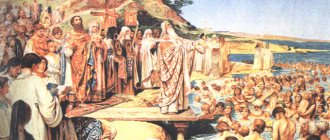Volume I. Introduction to Church History
I. Preliminary Concepts
II. Auxiliary Sciences for Church History
III. Sources of Church History
- 1. Monumental springs 2. Book sources of a general nature and their fundamental editions
* Creations of St. fathers and church writers. * Acts of the Councils. * Hagiographic monuments.
3. Special sources of church history
→ Greek church historiography - Eusebius of Caesarea - Successors of Eusebius in the 5th and 6th centuries. — Byzantine civil historians and chroniclers → Latin church historiography → Church historiography in Eastern languages
IV. Dividing church history into periods.
With the beginning of this period, we enter into a system of church life in general very close to that which exists to this day. The sphere of action, the everyday side of church life of the previous period, in its details is not entirely imaginable for us: the Church of the Martyrs, a society persecuted, denied, legally unrecognized and nevertheless living a life that presupposes significant publicity of discoveries - represents a phenomenon too peculiar, extraordinary . The interest that subsequent church history arouses is of a different kind - not so much aesthetic as practically positive. Church life in the present period takes on a normal character and fits more easily into the forms of representation developed by common experience. This period mediates - not only chronologically - between the later church history and its most ancient period. The unusually energetic church life vividly resembles the previous period; but it develops under such external relations as are common to the present period and subsequent ones. This combination of new forms and ancient content and power had significant consequences on almost all points of church life.
For the first time during this period, the question of the relationship between church and state appeared in a more natural formulation. During these 6 centuries, these relations took on forms that, with minor changes, have persisted to this day in most of the Christian world. Even those relations that exist as an exception in a few Christian states have their precedents in some, albeit isolated, phenomena of this period.
The relationship of the church to the pagan world outside the Roman Empire in the present period takes on a missionary | a character that they retain to this day: the slow influence of mass on mass, the gradual penetration of Christians into the environment of the pagan population is replaced by the external, mostly accidental influence on the pagan world of a few free or unwilling emissaries of the Christian world, the result of which is not the strengthening of the existing church, but the beginnings of new, branch.
The internal relations of Christian society in general are taking on such firm outlines that only their detailed elaboration remains for the future. The main points of hierarchical relations, laity and clergy, lower clergy to bishop, the internal ramifications of the episcopate itself remain unchanged. The forms of cathedral government, the position of the official clergy, officials, relative to the members of the hierarchy, are outlined quite clearly.
The history of theological thought constitutes the most brilliant page, and in one aspect it also constitutes a specific characteristic of this period. This point in church life in these centuries is the center towards which all the vital forces of the Christian church gravitate. Theological thought develops here in all its beauty and power. In the energy of its manifestations, in the unusual - for our time - in its breadth and depth of interest that theological thought arouses in various strata of society - one can feel the immediacy of the connection between this period and the previous one, when people lived by their religious convictions and knew how to stand for them to the point of selflessness. . In the minds of the greatest representatives of the church of our period, heroic steadfastness for Orthodoxy was a natural replacement for the heroism of the confessors of the previous period. The struggle against various abnormal manifestations of theological thought, going on in an unbroken chain through several centuries, is resolved with results so valuable in dogmatic terms that even conservative Protestantism does not dispute their high significance. The solution to the essential questions of Christianity about the Trinity, incarnation, grace in the present period is given in such formulas, against which modern critical theology could raise rather sharp objections, but could not offer anything more integral in their place, or even give a happy experience of resolving the perplexities raised by them . Along with and together with the revelation of the content of Christianity at the councils, individual theological thought also develops with remarkable power. The Greek Church of this period puts forward a whole galaxy of such deep and subtle theologians that other periods would be proud if they could count even a few of them. The Latin Church also in this period reaches the climax of its theological productivity, producing the most profound of its theologians and the most versatile of its scholars.
The liturgical order towards the end of this period - at least in the Greek church - reaches its completion, and subsequent history adds nothing more than a few touches to this area.
Moral life during this period develops new forms of ascetic achievement, unknown in the ancient church, which subsequently remain unchanged in the east, developing in all their diversity in the west. The general moral level of Christian life of this period is moving closer to subsequent ones - the result of the same general conditions for its discovery; its extensiveness does not develop without compromising its intensity.
Finally, if you pay attention to the phenomena of a negative order, then from this side the history of this period has made undoubted success. The subsequent period is characterized by the division of the Western and Eastern churches and the unusually rapid and strong development of the papacy. But the division of churches already in the present period is outlined not only in its possibility, not only in the favorable conditions and reasons that produced it - these reasons existed before Christianity itself - no, it was already given in its very discovery: the Greek and Latin churches have already experienced 35 years (484-519) in a formal gap between themselves, could in fact be convinced of the possibility of the existence of one without the other. Likewise, the papacy in our period not only arose, but also achieved, albeit imperceptibly, quite significant growth. Nicholas I, who opens the next period of church history, had quite solid precedents for himself; and this was, in the way of his thoughts and actions, a completely medieval pope.
Volume II. History of the Church in the period before Constantine the Great
Section one. Christianity and the pagan world: the struggle of Christianity with paganism in life and thought
- I. The Post-Apostolic Church and the Roman Empire
- 1. Martyrdom 2. Reasons for persecution of Christians 3. History of persecution
Classification
Period One Church sub umbraculo religionis licitae (judaicae) [under the cover of the permitted religion (Jewish)]
Period two Christianity as religio illicita (illegal religion)
Period three. The Christian Church as a society persecuted by the government itself
Christianity as a permitted religion
II. Apologies for Christianity and pagan polemics
III. The struggle of Christianity with pagan thought in the form of gnosis
- Danger to Christianity from Gnosis
- 1. Origin and general character of gnosis
- 2. Scheme of the content of Gnostic systems and their classification
- 3. The most important Gnostic systems of Ophite
- Basilides
- Valentine
- Carpocrates
- Saturninus
- Marcion
- Appendix: Mandaites (so-called "Christians of John the Baptist")
IV. Spread of Christianity
- 1. Sources of information about the spread of Christianity 2. The spread of Christianity in the East
- * Missionary activity of the apostles within the Ponto-Bosporan kingdom, Asia Minor and Parthia (in the broad sense). Christianity in Edessa * Christianity in Egypt, Libya and Pentapolis * Christianity in Persia * Christianity in Arabia * Appendix: Christianity in Ethiopia
3. The spread of Christianity in the West
Section two. The inner life of the church: clarification of dogmatic teaching and the principles of church discipline and ritual.
I. Disclosure of the doctrine of the God-man
1. The doctrine of Christ as God and the theory of the Logos. 2. Monarchianism. 3. The doctrine of the Holy Trinity of Tertullian and Origan and the general scheme for the construction of this doctrine in the ante-Nicene period. 4. The doctrine of the human nature of Christ in the ante-Nicene period. 5. Dynamic monarchianism of Pavel Samosatsky.
II. Experience of Origen's system of Christian gnosis
III. Montanism
IV. Discipline Disputes and Schisms in the Ancient Church
1. Schisms of Callistus and Hippolytus 2. Schisms of Novatus and Novatian 3. Dispute about the baptism of heretics 4. Schism of the Donatists 5. Melitian schism
V. Disputes about the time of celebrating Easter
VI. Church structure in the first three centuries of Christianity
Read online “Gadfly”
Ethel Voynich
Gadfly
Part one
Chapter I
– Can’t find it, dear? Leave it. I'll write this place again. Probably the page got lost somewhere, and all this time you looked for it in vain.
Montanelli had a low, thick, sonorous voice, the silvery purity of tone imparted a special charm to his speech. One could feel the voice of a born orator, flexible, rich in nuances, and one could hear endless affection in it every time Father Rector addressed Arthur.
Arthur approached with soft, silent steps that always irritated his family. Small in stature and frail in appearance, he looked more like an Italian of the sixteenth century than a youth of the thirties who came from an average English family. Everything about him was too polished and elegant: long eyebrows, a mobile, nervous mouth, arms, legs. When he sat quietly, it was easy to take him for a pretty girl dressed in a man's dress; but with his flexible movements he resembled a tamed panther that does not show its claws.
- Did you really find it? What would I do without you, Arthur? I would always lose everything. Well, that’s enough... I’ll end here and won’t write any more for now. Let's go to the garden, I will help you understand your work. What don't you understand?
At university, Arthur studied philosophy. Whenever he encountered a difficult passage, he turned to the padre for clarification. He was never a student of the seminary, but Montanelli was an authority for him in all branches of knowledge.
“I’ll go now,” said Arthur, when the difficult part had been explained. - But maybe you need me?
- No, I’ve finished my work for now, but I would like you to stay with me for a while - just like that, without anything to do. You are free?
- Oh yeah!
“You look so tired, my dear,” he said.
- It's nothing you can do.
There was weariness in Arthur's voice, and Montanelli noticed it immediately.
- Oh, padre, what's the use? Now, after my mother’s death, I am unable to stay in this house. Julia would drive me crazy.
Julia was the wife of his older half-brother and took every opportunity to make his life miserable.
“There is no need for you to stay with relatives,” Montanelli answered him softly. - Without a doubt, this is the worst thing for you. But you can go to your friend the doctor.
. You will spend a month there, and then you will be able to work again.
- No, padre, I really can’t! The Warrens are good, warm-hearted people, but they don't understand me. They sympathize with my grief - I can see it in their faces. But they would console me, talk about my mother... Gemma, of course, is not like that... she always understood with instinct what not to talk about. Even when we were still kids. Others are not so sensitive. And not only that...
- What else, my son?
Arthur plucked several flowers from a fallen foxglove branch and nervously fingered them in his hand.
“I can’t live in this city,” he began after a moment’s pause. – There are shops in the city where she usually bought me toys; the embankment where I walked with her while she was not yet sick. Wherever I go, everything is the same. Just like before, every flower girl at the market comes up to me and offers flowers... As if I need them now! And then this cemetery... No, I can’t be there - it’s hard to see all this.
Arthur fell silent. He absentmindedly tore the foxglove bells into small pieces. The silence lasted a long time. It was so tiresome that Arthur finally began to wonder why Montanelli wasn't talking. Dusk was already gathering under the magnolia branches. Everything was shrouded in them and took on bizarre, capricious shapes; but it had not yet become so dark that the canon’s deathly pale face could not be seen. With his head bowed low, he held tightly to the edge of the bench with his right hand. Arthur turned away with a feeling of awe at this great soul.
“Oh God,” he thought, “how petty and selfish I am! If my grief were his grief, he could not feel it more deeply.”
Montanelli raised his head and looked around.
- Okay, I won’t insist that you go there. At least now,” he said with affection in his voice. – But promise me that you will have a good rest and use the summer holidays for your health...
I. Preliminary Concepts 1-39
1. The concept of history. —History as a science, honoris causa (1-5).—The meaning of the word “history”; the difference between γνῶσις and εἴδησις and the task of history (6-8).
2. The concept of the church . - Names of the church from the place of liturgical meetings (Kirche, church) (9-10). - Meaning of the names ἐκκλησία and edta (10-14).
3. The work of a historian. —a) Collection of material (14).—b) Lower criticism (14–18) and higher (18–22). An example of applying the techniques of historical criticism to the news of the baptism of Constantine V. (22-26).-c) Establishing a connection between events (27-28).
4. Objectivity and confessionalism in church history - The demand for love of truth from the historian (28-29). - Objection to the objectivity of church history as a theological science (29-30). - Confessionalism in church history (30-32). - Attitude to the history of various Christian denominations (32-38).—The question of the usefulness of church history (38-39).
IV. Division of church history into periods 212-228
The significance of dividing history into periods (212-213).—The division of church history into two periods: before the Reformation and after the Reformation (213).—The division into three periods and the question of the boundary between ancient and middle times: the era of Constantine V., later moments (213-214).—Division into periods according to the forms of formation of Christian life (214-216).—Wolff’s attempt (216-218).—Division of churches, as the basis for dividing church history into periods and the comparative significance of the separation from the Eastern Church of Monophysitism and Western Church (218-219).—The separation of the Monophysites and the sixth ecumenical council, as an era (219-221).—The division of the churches under Photius and Michael Cerullarius (221-226).—The border of the first half-period (Edict of Milan 313) ( 226-227).—The Apostolic period as a subject of biblical history (227-228).
Name index 229—234
Page generated in 0.02 seconds!
II. Auxiliary Sciences for Church History. 39—105
Diplomacy (40—43). - Sphragistics . (43-44). — Epigraphy (44). — Numismatics (44). — Paleography . Writing material (44-46); tasks of paleography: reading manuscripts (46-48) and determining the time and place of their writing (48-52); the significance of paleography (52-54). — Philology and its significance (54-57). — Geography . The meaning of geographical proper names (57-58); manuals and primary sources on the historical geography of the ancient world and church geography (58-60). Church statistics (60). — Onomatology (prosopography). Aids for determining the proper names of bishops and other persons (61-64).— Law. Aids for understanding job titles (64-65).— Metrology , metrological titles (65-66).— Material and formal chronology Works on 1) material chronology (67-69). 2) Formal chronology (69-71): a) technical (71-73) and b) mathematical (astronomical) (73-76). - Information about different eras and methods of chronology. - Roman chronology according to consuls (76-82); era ab urbe condita and Greek reckoning according to the Olympiads (82).—Eastern (Syrian) reckoning: Seleucid era (83-84); Antiochian era (84).—Egyptian chronology: era of Diocletian (84-85)—R. X. chronology (era of Dionysius) (86-87); Spanish era (87). The question of the time of the birth and death of Christ (87-92). Calculation from the creation of the world: traditional date (5500), Byzantine and Alexandrian reckoning (Annian era) (92-95).—Table of dates for various eras for the time from 44 BC to 42 AD. R. X. (96 - 98). - Abyssinian, Georgian and Armenian chronology (98-100). - Muslim chronology (101-102). — Byzantine chronology according to indictions (102 -105).





